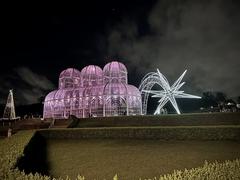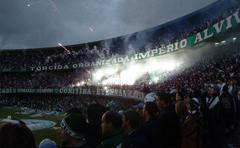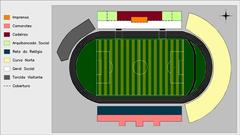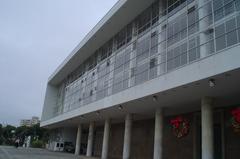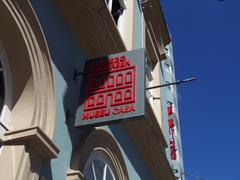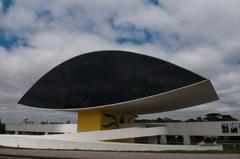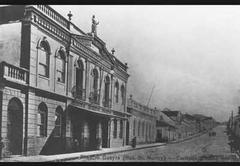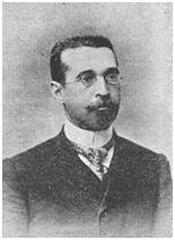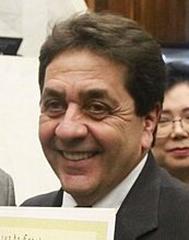
Memorial Ucraniano Curitiba: Visiting Hours, Tickets, and Historical Significance
Date: 04/07/2025
Introduction
Nestled in the scenic Parque Tingui, the Memorial Ucraniano in Curitiba is a vibrant tribute to the rich heritage and cultural legacy of Ukrainian immigrants in Brazil. Celebrating over a century since the first Ukrainians arrived in Paraná, the memorial preserves and showcases their journey, resilience, and enduring influence on the region’s social and cultural landscape. This guide offers a comprehensive overview of the Memorial Ucraniano, including its historical context, architectural highlights, practical visitor information, cultural programming, and travel tips.
Whether you are a history enthusiast, cultural explorer, or a traveler seeking to experience Curitiba’s historical sites, the Memorial Ucraniano offers an immersive and enlightening exploration of Ukrainian-Brazilian heritage. (Fui Ser Viajante, Wikipedia, Curitiba Turismo)
Historical Background: Ukrainian Immigration to Paraná
Early Waves and Settlement
The Ukrainian presence in Paraná began in 1891, when the first group of eight families settled in Colônia Santa Bárbara. This initial migration soon grew; by 1914, the Ukrainian population in Paraná had reached approximately 45,000, with most immigrants coming from Galicia (then under Austro-Hungarian rule). These pioneers faced formidable challenges—uncultivated land, disease, and hunger—but laid the foundation for a thriving community. (Encyclopedia of Ukraine, Emerging Europe)
Key settlements included Água Amarela (now Antonio Olinto), União da Vitória, Mallet, Dorizon, and especially Prudentópolis, where Ukrainian heritage remains strong and Ukrainian is an official language. The Ukrainian Greek Catholic Church quickly became a central pillar, preserving faith, language, and traditions.
Subsequent Immigration and Community Growth
Between the World Wars, a further 9,000 Ukrainians arrived from regions such as Volhynia and Bukovina, bringing new energy to the community. The post-World War II period saw another 7,000 refugees, many of them intellectuals. By the late 20th century, Paraná’s Ukrainian-Brazilian population numbered over 500,000, making it one of the largest Ukrainian diasporas in the world. (Wikipedia, Scholars at Risk)
Cultural Preservation and Integration
Ukrainian Brazilians are known for their success in preserving language, religion, and customs, thanks largely to the Ukrainian Greek Catholic Church, which maintains over 230 churches in Paraná. Cultural associations, schools, and research centers such as the Ukrainian Brazilian Central Representation and the Brazilian Center for Ukrainian Studies play key roles in maintaining traditions and promoting Ukrainian studies in Brazil.
Socioeconomic Contributions and Modern Developments
Initially working as agricultural laborers, Ukrainians contributed to Paraná’s infrastructure and gradually diversified into education, commerce, and public service. In recent years, the community has demonstrated solidarity with Ukraine, notably during humanitarian crises, reinforcing its ongoing ties to the ancestral homeland. (Emerging Europe, Scholars at Risk)
The Memorial Ucraniano: Architecture and Cultural Symbolism
Site Overview
Inaugurated in 1995 to commemorate the centenary of Ukrainian immigration, the Memorial Ucraniano is set within Parque Tingui and features a faithful wooden replica of the Igreja de São Miguel (Saint Michael the Archangel Church) from Mallet, Paraná. The church’s distinctive wooden construction, domed roof, and Byzantine-inspired architecture honor the craftsmanship and faith of early settlers. (Wikipedia - Memorial Ucraniano, Curitiba Turismo)
Key Features
- Wooden Church: Built in traditional interlocking log style, the church is octagonal, with a steep roof and central dome. Inside, visitors find religious icons, embroidered cloths, and pysanky, reflecting deep spiritual and artistic traditions.
- Campanile (Bell Tower): Standing adjacent to the church, this wooden structure echoes village churches in Ukraine and symbolizes the community’s unity.
- Pysanka Monument: A large, vibrantly decorated Easter egg sculpture, created by artist Jorge Seratiuk, stands as a central symbol of Ukrainian folk art and renewal.
- Typical Ukrainian House: The reconstructed peasant house displays period furniture, textiles, and artifacts, offering insight into early immigrant life.
- Museum and Exhibition Space: Showcases traditional clothing, religious icons, musical instruments, and documents chronicling the Ukrainian-Brazilian experience.
The landscaping features sunflowers and wheat motifs, evoking the Ukrainian countryside and agricultural heritage. (Gazeta do Povo)
Visiting the Memorial Ucraniano: Hours, Admission, and Accessibility
Location
- Address: Parque Tingui, R. Nicolo Paganini, s/n – Pilarzinho, Curitiba – PR, 81720-300
- How to Get There: Easily accessible by car, public transportation, or via Curitiba’s Tourism Line bus. The 967 Júlio Graf bus line from Praça Tiradentes stops near the entrance.
Visiting Hours and Admission
- Opening Hours: Generally open Tuesday to Sunday, from 9:00 AM to 5:00 PM (some sources indicate daily opening, 8:00 AM to 6:00 PM—check the official tourism website for current details).
- Admission: Free of charge for all visitors, including access to the church, museum, and exhibitions.
Facilities and Accessibility
- On-site: Paved walkways, benches, green spaces, picnic areas, restrooms, and a souvenir shop with pysanky and crafts.
- Accessibility: Ramps and wide pathways accommodate visitors with mobility challenges; parking is available nearby.
- Nearby Attractions: Parque Tingui features other immigrant heritage monuments such as the Polish and German memorials. The Curitiba Botanical Garden and Oscar Niemeyer Museum are also within easy reach for those planning a full-day cultural outing.
Cultural Events and Educational Programming
The Memorial Ucraniano is a vibrant hub throughout the year, hosting:
- Ukrainian Easter (Páscoa Ucraniana): Includes the Blessing of Foods, pysanka-making, and folk performances.
- Festa Nacional da Ucrânia & Festa do Pêssankas: Feature traditional music, dance, cuisine, and crafts.
- Workshops and Exhibitions: Focus on Ukrainian language, history, folk art, and cuisine.
- Religious Services: The site hosts Orthodox and Greek Catholic liturgies, weddings, and commemorative masses, reinforcing spiritual and cultural bonds.
The memorial collaborates with schools and cultural organizations to provide guided tours, lectures, and workshops, supporting cultural preservation and education for all ages. (UFPR)
Visitor Experience and Practical Tips
- Guided Tours: Available in Portuguese and, occasionally, Ukrainian or English. Advance booking may be necessary for groups or during festivals.
- Best Time to Visit: Weekdays and early mornings are less crowded; major festivals offer the richest experiences but draw larger crowds.
- Photography: The wooden church, pysanka monument, and park setting provide excellent photo opportunities—especially in the late afternoon.
- Duration: Plan at least 1–2 hours to explore the site and enjoy the amenities.
- Combine with Other Attractions: Extend your visit to include other Parque Tingui monuments or incorporate stops at the Botanical Garden and Niemeyer Museum.
Role in Solidarity and Community
Beyond its historical and cultural functions, the Memorial Ucraniano has become a center for humanitarian solidarity with Ukraine, especially in response to recent geopolitical challenges. It has hosted vigils, fundraising events, and informational campaigns, reinforcing its role as a living institution, responsive to both the past and present needs of the community. (Bem Paraná)
Frequently Asked Questions (FAQ)
Q: What are the Memorial Ucraniano visiting hours?
A: Typically open Tuesday to Sunday, 9:00 AM to 5:00 PM; check the official website for updates.
Q: Is there an entrance fee or are tickets required?
A: Admission is free; no tickets are needed.
Q: Are guided tours available?
A: Yes, guided tours are offered in Portuguese and sometimes in Ukrainian or English, especially during festivals and by prior arrangement.
Q: Is the site accessible for people with disabilities?
A: Yes, the memorial has ramps and accessible pathways, and parking is available nearby.
Q: When are major cultural events held?
A: Ukrainian Easter and the Easter Egg Festival (Festa do Pêssankas) are annual highlights, along with other cultural and religious celebrations.
Q: What other attractions are nearby?
A: The memorial is within Parque Tingui, near other immigrant heritage sites and recreational areas.
Conclusion
The Memorial Ucraniano in Curitiba is more than a historical monument—it is a living celebration of Ukrainian-Brazilian heritage, blending architectural beauty, cultural vibrancy, and community spirit. With free admission, accessible facilities, and year-round programming, it stands as a symbol of multiculturalism and resilience. Whether you visit during a major festival or for a quiet day of exploration, the Memorial Ucraniano offers a rich, authentic, and memorable experience.
To enhance your visit, consider downloading the Audiala app for guided tours and up-to-date event information. Follow us on social media for the latest news and insights into Curitiba’s cultural scene.
Sources and Further Reading
- Fui Ser Viajante – Memorial Ucraniano Curitiba
- Wikipedia – Memorial Ucraniano
- Curitiba Turismo – Memorial Ucraniano
- Gazeta do Povo – Memorial Ucraniano
- Emerging Europe – The Ukrainians of Brazil
- Scholars at Risk – Welcoming Ukrainian Scientists in Paraná
- UFPR – Curitiba Celebra Cultura Ucraniana
- Bem Paraná – Memorial Ucraniano Solidariedade à Ucrânia





